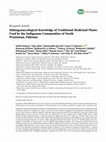Papers by Noha Mohamed Abubakr Elsaid

Evidence-Based Complementary and Alternative Medicine
Background. Since the beginning of civilization, medicinal plants have been used in human healthc... more Background. Since the beginning of civilization, medicinal plants have been used in human healthcare systems. Studies have been conducted worldwide to evaluate their efficacy, and some of the results have triggered the development of plant-based medications. Rural women in Pakistan frequently experience gynaecological disorders due to malnutrition and heavy physical work during pregnancy. Due to the low economic status, the remoteness of the area, and the lack of modern health services, herbal therapy for gynaecological disorders is common among the indigenous tribes of the study area. Methods. Field surveys were carried out from April 2018 to October 2020 to collect data regarding medicinal plants used for different gynaecological disorders. A semistructured questionnaire was used to collect ethnogynaecological data. Results. In total, 67 medicinal plant species belonging to 38 families are being used to treat 26 different gynaecological problems. The herbaceous growth form and the...

Ethnogynaecological Knowledge of Traditional Medicinal Plants Used by the Indigenous Communities of North Waziristan, Pakistan, 2022
Background. Since the beginning of civilization, medicinal plants have been used in human healthc... more Background. Since the beginning of civilization, medicinal plants have been used in human healthcare systems. Studies have been conducted worldwide to evaluate their e cacy, and some of the results have triggered the development of plant-based medications. Rural women in Pakistan frequently experience gynaecological disorders due to malnutrition and heavy physical work during pregnancy. Due to the low economic status, the remoteness of the area, and the lack of modern health services, herbal therapy for gynaecological disorders is common among the indigenous tribes of the study area. Methods. Field surveys were carried out from April 2018 to October 2020 to collect data regarding medicinal plants used for di erent gynaecological disorders. A semistructured questionnaire was used to collect ethnogynaecological data. Results. In total, 67 medicinal plant species belonging to 38 families are being used to treat 26 di erent gynaecological problems. e herbaceous growth form and the Lamiaceae family were recorded with the maximum number of plant species (42 species and 7 species, respectively). Leaves are the most highly utilized plant part, with 16 species. In the case preparation method, decoction was the dominant method (25 species, 36.76%). e informants reported the maximum number of species for the treatment of irregular menstrual ow as 11 species (15.28%). e highest relative frequency of citation (RFC) value was obtained for Acacia modesta (0.37), and the use value (UV) for Tecomella undulata (0.85). e highest informants' consensus factor (ICF) value (1.0) was obtained for emmenagogue and tonic

Egyptian Journal of Medical Microbiology, 2021
Background: Urinary tract infection (UTI) is considered one of the most common bacterial infectio... more Background: Urinary tract infection (UTI) is considered one of the most common bacterial infections seen in health care. To our knowledge, there is no available antimicrobial resistance surveillance system for monitoring of community-acquired UTIs (CA- UTIs) in our country. Objectives: we aimed to discuss the bacterial pattern and resistance profile of CA-UTIs in Ismailia, Egypt. Methods: This cross-sectional study included 400 patients suffering from symptoms of acute UTIs. Urine specimens were collected by clean-catch mid-stream method, examined microscopically and inoculated immediately on blood agar and MacConkey's agar plates. Colony counting, isolation and identification of the urinary pathogens were performed by the conventional biochemical tests according to the isolated organism. Antibiotic susceptibility testing was performed by Kirby Bauer disk diffusion method. Interpretation was performed according to Clinical Laboratory Standard Institute (CLSI) guidelines. Results...

BMJ Open
ObjectiveThis study assessed perceived stress, anxiety and depression among healthcare workers fa... more ObjectiveThis study assessed perceived stress, anxiety and depression among healthcare workers facing the COVID-19 pandemic in Egypt.SettingThis was an online study where a Google form was prepared including sociodemographic and occupational data as well as three validated questionnaires to assess perceived stress, anxiety and depression, respectively. The form was distributed online to all social media groups including healthcare workers all across the country, and responses were collected until the sample size of 262.ParticipantsHealthcare workers (physicians, dentists, pharmacists, physiotherapists, nurses, technicians and administrators) working in governmental or educational hospitals from all Egyptian governorates who are members of social media groups. The mean age of participants was 33.4±5.9 years, 70% were women, about 70% were married and 66% were physicians.OutcomesThe frequency of perceived stress, anxiety and depression observed among the study participants according t...

The Egyptian Journal of Hospital Medicine
Background: Many adaptations to medical education have been made in response to the new emergent ... more Background: Many adaptations to medical education have been made in response to the new emergent COVID-19 pandemic and its enormous global effects including the teaching and learning strategies to assure the educational process's safety and advancement. Accordingly, it was necessary to implement new online instructional approaches at the Faculty of Medicine, Suez Canal University in Egypt. Objective: To assess online learning advantages and disadvantages as perceived by medical students in addition to their preference regarding online vs face-to-face learning, Subjects and methods: This study was conducted as a cross-sectional study that included 340 students who filled an online survey consisting of 16 questions and was conducted on the Google Forms platform. Target population: years 1, 2 and 3 undergraduate medical students at Faculty of Medicine, Suez Canal University who experienced online learning during the COVID-19 pandemic. Results: The mean age of students was 19.57±1.02, ranged from 17 to 23 years, 61% of them were females. About 63.8% of students had no previous experience with online learning. The main perceived advantages were the ability to stay home (63.8%), comfortable surrounding (52.1%) and access to online materials (47.1%), while the main perceived disadvantages were technical problems (67.6%), lack of interaction with patients (58.8%), and reduced interaction with teachers (48.5%). Most of the students found face-to-face learning is superior to online learning in improving the knowledge (p=0.005), clinical skills (p<0.001) and social competence (p<0.001). Though 77% of them rated online learning as enjoyable. Conclusion: Most of our participants preferred traditional face-to-face learning over the online learning. Stakeholders should take the required steps to improve learning by reducing the disadvantages and increasing advantages of online learning as perceived by students during this study.

Objective This study assessed perceived stress, anxiety and depression among healthcare workers f... more Objective This study assessed perceived stress, anxiety and depression among healthcare workers facing the COVID-19 pandemic in Egypt. Setting This was an online study where a Google form was prepared including sociodemographic and occupational data as well as three validated questionnaires to assess perceived stress, anxiety and depression, respectively. The form was distributed online to all social media groups including healthcare workers all across the country, and responses were collected until the sample size of 262. Participants Healthcare workers (physicians, dentists, pharmacists, physiotherapists, nurses, technicians and administrators) working in governmental or educational hospitals from all Egyptian governorates who are members of social media groups. The mean age of participants was 33.4±5.9 years, 70% were women, about 70% were married and 66% were physicians. Outcomes The frequency of perceived stress, anxiety and depression observed among the study participants according to the results of their questionnaires. Then the frequencies were compared between different sociodemographic characteristics. Results Only 1.3% showed low perceived stress while 98.5% showed moderate to severe stress. About 9.5% did not experience generalised anxiety, while the remaining 90.5% had different degrees of anxiety as mild anxiety showed the highest per cent affecting about 40% of participants followed by moderate anxiety about 32% then severe anxiety, 18.5%. With regard to depression, 94% of participants showed mild to severe depression. Conclusion This study showed a high prevalence of perceived stress, anxiety and depression among healthcare workers during the COVID-19 pandemic that affected all workers regardless of different sociodemographic characteristics.

Background: Urinary tract infection (UTI) is considered one of the most common bacterial infectio... more Background: Urinary tract infection (UTI) is considered one of the most common bacterial infections seen in health care. To our knowledge, there is no available antimicrobial resistance surveillance system for monitoring of community-acquired UTIs (CA-UTIs) in our country. Objectives: we aimed to discuss the bacterial pattern and resistance profile of CA-UTIs in Ismailia, Egypt. Methods: This cross-sectional study included 400 patients suffering from symptoms of acute UTIs. Urine specimens were collected by clean-catch mid-stream method, examined microscopically and inoculated immediately on blood agar and MacConkey's agar plates. Colony counting, isolation and identification of the urinary pathogens were performed by the conventional biochemical tests according to the isolated organism. Antibiotic susceptibility testing was performed by Kirby Bauer disk diffusion method. Interpretation was performed according to Clinical Laboratory Standard Institute (CLSI) guidelines. Results: out of 400 specimens, 136 of them revealed no bacterial growth or insignificant bacteriuria. Most of participants with UTI were females (81.8%) (p=0.008) and 54.5% of them were married (P=0.1). Gram negative bacteria were more common than Gram positive representing 66 % and 34% respectively. E. coli was the most common isolated organism (39%) followed by S. aureus (32%), K. Pneumoniae and Pseudomonas (10.5% for each), Proteus (6%) and Enterococci (2%). E. coli isolates showed the highest susceptibility to imipenem, meropenem, amikacin, nitrofurantoin, levofloxacin and ciprofloxacin. Most of our patients were diabetics (64.8%) (p=0.004). The mean ± SD of HbA1c was 6.4±2.0 with 4 to 12.6 range, S.E was 0.1 and 95% C.I was 6.2-6.7. The highest mean ± SD of HbA1c was in S. aureus infections. Conclusion: Gram negative bacteria were most common than Gram positive with predominance of E. coli with significant relation to the presence of diabetes.

Background: Many adaptations to medical education have been made in response to the new emergent ... more Background: Many adaptations to medical education have been made in response to the new emergent COVID-19 pandemic and its enormous global effects including the teaching and learning strategies to assure the educational process's safety and advancement. Accordingly, it was necessary to implement new online instructional approaches at the Faculty of Medicine, Suez Canal University in Egypt. Objective: To assess online learning advantages and disadvantages as perceived by medical students in addition to their preference regarding online vs face-to-face learning, Subjects and methods: This study was conducted as a cross-sectional study that included 340 students who filled an online survey consisting of 16 questions and was conducted on the Google Forms platform. Target population: years 1, 2 and 3 undergraduate medical students at Faculty of Medicine, Suez Canal University who experienced online learning during the COVID-19 pandemic. Results: The mean age of students was 19.57±1.02, ranged from 17 to 23 years, 61% of them were females. About 63.8% of students had no previous experience with online learning. The main perceived advantages were the ability to stay home (63.8%), comfortable surrounding (52.1%) and access to online materials (47.1%), while the main perceived disadvantages were technical problems (67.6%), lack of interaction with patients (58.8%), and reduced interaction with teachers (48.5%). Most of the students found face-to-face learning is superior to online learning in improving the knowledge (p=0.005), clinical skills (p<0.001) and social competence (p<0.001). Though 77% of them rated online learning as enjoyable. Conclusion: Most of our participants preferred traditional face-to-face learning over the online learning. Stakeholders should take the required steps to improve learning by reducing the disadvantages and increasing advantages of online learning as perceived by students during this study.











Uploads
Papers by Noha Mohamed Abubakr Elsaid